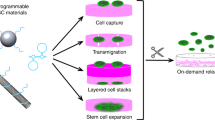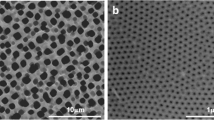Abstract
Fabrication of microstructured patterns serves as a powerful tool for studying the cellular responses toward synthetic materials at the material–cell interface for tissue engineering. Silica particles can effectively act as a substrate for cellular attachment and growth owing to its biocompatible nature and facile surface chemistry. In the current study, a non-lithographic microfabrication method for patterning of particles was devised using silica particles (~ 600 nm) and epoxy-silane-functionalized glass surfaces. Poly-l-lysine (PLL) was covalently attached to modified silica particles which were subsequently patterned onto the functionalized glass surfaces. PLL played a dual role. Firstly, it served as a bi-linker by covalently attaching modified particles on epoxy functionalized glass surfaces. Secondly, it facilitated cellular attachment on the pattern via electrostatic interactions. The vacant unpatterned regions were passivated with methoxy-polyethylene glycol-amino (MPA) to avoid non-specific cellular attachments. A549 cells were found to grow specifically on the monolayered silica patterns having lower packing density and exhibited stretched morphology, indicating cellular attachment to the substrate, whereas the MPA passivated areas were capable of blocking cell adhesion successfully. The highlight of the reported novel method lies in the dual use of PLL which not only provided necessary control over the surface chemistry by allowing fabrication of desired patterns but also facilitated selective cellular attachment on the generated patterns. Therefore, we report a simple process for micropatterning the cells on desired patterns via surface bi-functionalization for selective cellular attachment and proliferation.






Similar content being viewed by others
References
Voldman J, Gray ML, Schmidt MA (1999) Microfabrication in biology and medicine. Annu Rev Biomed Eng 1(1):401–425
Csucs G, Michel R, Lussi JW, Textor M, Danuser G (2003) Microcontact printing of novel co-polymers in combination with proteins for cell-biological applications. Biomaterials 24(10):1713–1720
Koh WG, Itle LJ, Pishko MV (2003) Molding of hydrogel microstructures to create multiphenotype cell microarray. Anal Chem 75(21):5783–5789
Jaiswal N, Hens A, Chatterjee M, Mahata N, Chanda N (2018) Polymeric-patterned surface for biomedical applications. Environmental, chemical and medical sensors. Springer, Singapore, pp 227–251
Yap FL, Zhang Y (2007) Protein and cell micropatterning and its integration with micro/nanoparticles assembly. Biosens Bioelectron 22(6):775–788
Liu Q, Wu C, Cai H, Hu N, Zhou J, Wang P (2014) Cell-based biosensors and their application in biomedicine. Chem Rev 114(12):6423–6461
Falconnet D, Csucs G, Grandin HM, Textor M (2006) Surface engineering approaches to micropattern surfaces for cell-based assays. Biomaterials 27(16):3044–3063
Gu MB, Mitchell RJ, Kim BC (2004) Whole-cell-based biosensors for environmental biomonitoring and application. Biomanufacturing. Springer, Berlin, pp 269–305
Guillotin B, Guillemot F (2011) Cell patterning technologies for organotypic tissue fabrication. Trends Biotechnol 29(4):183–190
Carrico IS, Maskarinec SA, Heilshorn SC, Mock ML, Liu JC, Nowatzki PJ, Franck C, Ravichandran G, Tirrell DA (2007) Lithographic patterning of photoreactive cell-adhesive proteins. J Am Chem Soc 129(16):4874–4875
Whitesides GM, Ostuni E, Takayama S, Jiang X, Ingber DE (2001) Soft lithography in biology and biochemistry. Annu Rev Biomed Eng 3(1):335–373
Kane RS, Takayama S, Ostuni E, Ingber DE, Whitesides GM (2006) Patterning proteins and cells using soft lithography. In: Williams DF (ed) The biomaterials: silver jubilee compendium. Elsevier, Amsterdam, pp 161–174
Suh KY, Seong J, Khademhosseini A, Laibinis PE, Langer R (2004) A simple soft lithographic route to fabrication of poly(ethylene glycol) microstructures for protein and cell patterning. Biomaterials 25(3):557–563
Ramalingama M, Tiwari A (2010) Spatially controlled cell growth using patterned biomaterials. Adv Mater Lett 1:179–187
Takeda I, Kawanabe M, Kaneko A (2015) Autonomous patterning of cells on microstructured fine particles. Mater Sci Eng C 50:173–178
Ito Y (1999) Surface micropatterning to regulate cell functions. Biomaterials 20(23):2333–2342
Halas NJ (2008) Nanoscience under glass: the versatile chemistry of silica nanostructures. ACS Nano 2(2):179–183
Tarpani L, Morena F, Gambucci M, Zampini G, Massaro G, Argentati C, Emiliani C, Martino S, Latterini L (2016) The influence of modified silica nanomaterials on adult stem cell culture. Nanomaterials 6(6):E104. https://doi.org/10.3390/nano6060104
Colilla M, Martínez-Carmona M, Sánchez-Salcedo S, Ruiz-González ML, González-Calbet JM, Vallet-Regí M (2014) A novel zwitterionic bioceramic with dual antibacterial capability. J Mater Chem B 2(34):5639–5651
Huo Q, Liu J, Wang LQ, Jiang Y, Lambert TN, Fang E (2006) A new class of silica cross-linked micellar core–shell nanoparticles. J Am Chem Soc 128(19):6447–6453
Ambrogi V, Perioli L, Pagano C, Latterini L, Marmottini F, Ricci M, Rossi C (2012) MCM-41 for furosemide dissolution improvement. Microp Mesop Mater 147(1):343–349
Latterini L, Tarpani L (2011) Hierarchical assembly of nanostructures to decouple fluorescence and photothermal effect. J Phys Chem C 115(43):21098–21104
Leidner A, Weigel S, Bauer J, Reiber J, Angelin A, Grösche M, Scharnweber T, Niemeyer CM (2018) Biopebbles: DNA-functionalized core–shell silica nanospheres for cellular uptake and cell guidance studies. Adv Funct Mater 28(18):1707572
Witecka A, Yamamoto A, Swieszkowski W (2014) Improvement of cytocompatibility of magnesium alloy ZM21 by surface modification. Magnesium technology. Springer, Berlin, pp 375–380
Karakoy M, Gultepe E, Pandey S, Khashab MA, Gracias DH (2014) Silane surface modification for improved bioadhesion of esophageal stents. Appl Surf Sci 311:684–689
Kim JB, Premkumar T, Giani O, Robin JJ, Schue F, Geckeler KE (2007) A mechanochemical approach to nanocomposites using single-wall carbon nanotubes and poly(l-lysine). Macromol Rapid Commun 28(6):767–771
Shan C, Yang H, Han D, Zhang Q, Ivaska A, Niu L (2009) Water-soluble graphene covalently functionalized by biocompatible poly-l-lysine. Langmuir 25(20):12030–12033
Kuo YC, Ku HF, Rajesh R (2017) Chitosan/γ-poly(glutamic acid) scaffolds with surface-modified albumin, elastin and poly-l-lysine for cartilage tissue engineering. Mater Sci Eng C 78:265–277
Liu T, Hu Y, Tan J, Liu S, Chen J, Guo X, Pan C, Li X (2017) Surface biomimetic modification with laminin-loaded heparin/poly-l-lysine nanoparticles for improving the biocompatibility. Mater Sci Eng C 71:929–936
Markov A, Wolf N, Yuan X, Mayer D, Maybeck V, Offenhäusser A, Wördenweber R (2017) Controlled engineering of oxide surfaces for bioelectronics applications using organic mixed monolayers. ACS Appl Mater Interfaces 9(34):29265–29272
Jolles A, Neurath F (1898) A colorimetric method of determining silica in water. Z Angew Chem 11:315
Lin J, Siddiqui JA, Ottenbrite RM (2001) Surface modification of inorganic oxide particles with silane coupling agent and organic dyes. Polym Adv Technol 12(5):285–292
Zhuravlev LT (2000) The surface chemistry of amorphous silica. Zhuravlev model. Colloids Surf A Physicochem Eng Asp 173(1–3):1–38
Khademhosseini A, Suh KY, Yang JM, Eng G, Yeh J, Levenberg S, Langer R (2004) Layer-by-layer deposition of hyaluronic acid and poly-l-lysine for patterned cell co-cultures. Biomaterials 25(17):3583–3592
Hoppe A, Güldal NS, Boccaccini AR (2011) A review of the biological response to ionic dissolution products from bioactive glasses and glass-ceramics. Biomaterials 32(11):2757–2774
Chandradoss SD, Haagsma AC, Lee YK, Hwang JH, Nam JM, Joo C (2014) Surface passivation for single-molecule protein studies. J Vis Exp. https://doi.org/10.3791/50549
Acknowledgements
This study was financially supported by JNU in terms of UPE-II Grant (Grant No. 0046), DST-PURSE (PAC-JNU-DST-PURSE-462 (Phase-II)) and DST-SERB (Grant No. ECR/2015/000498 and YSS/2015/002007). We are thankful to JNU-UGC and DBT for fellowship. We would also like to thank Dr. Gajendra Saini for TEM, Dr. Ruchita Pal for SEM, Mr. Prabhat Kumar for Bright Field Imaging and Mr. Ashok Kumar Sahu for Confocal Analysis at AIRF, JNU.
Author information
Authors and Affiliations
Corresponding authors
Ethics declarations
Conflict of interest
All authors declare that they have no conflict of interest.
Electronic supplementary material
Below is the link to the electronic supplementary material.
Rights and permissions
About this article
Cite this article
Jindal, A., Yadav, N., Dhar, K. et al. Bi-functionalization of glass surfaces with poly-l-lysine conjugated silica particles and polyethylene glycol for selective cellular attachment and proliferation. J Mater Sci 54, 2501–2513 (2019). https://doi.org/10.1007/s10853-018-2950-8
Received:
Accepted:
Published:
Issue Date:
DOI: https://doi.org/10.1007/s10853-018-2950-8




